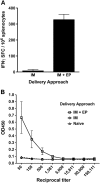Clinical applications of DNA vaccines: current progress
- PMID: 21765081
- PMCID: PMC3202319
- DOI: 10.1093/cid/cir334
Clinical applications of DNA vaccines: current progress
Abstract
It was discovered almost 20 years ago that plasmid DNA, when injected into the skin or muscle of mice, could induce immune responses to encoded antigens. Since that time, there has since been much progress in understanding the basic biology behind this deceptively simple vaccine platform and much technological advancement to enhance immune potency. Among these advancements are improved formulations and improved physical methods of delivery, which increase the uptake of vaccine plasmids by cells; optimization of vaccine vectors and encoded antigens; and the development of novel formulations and adjuvants to augment and direct the host immune response. The ability of the current, or second-generation, DNA vaccines to induce more-potent cellular and humoral responses opens up this platform to be examined in both preventative and therapeutic arenas. This review focuses on these advances and discusses both preventive and immunotherapeutic clinical applications.
Figures


References
-
- Tang DC, DeVit M, Johnston SA. Genetic immunization is a simple method for eliciting an immune response. Nature. 1992;356:152–154. - PubMed
-
- Ulmer JB, Donnelly JJ, Parker SE, et al. Heterologous protection against influenza by injection of DNA encoding a viral protein. Science. 1993;259:1745–1749. - PubMed
-
- Wang B, Agadjanyan MG, Srikantan V, et al. Molecular cloning, expression, and biological characterization of an HTLV-II envelope glycoprotein: HIV-1 expression is permissive for HTLV-II-induced cell fusion. AIDS Res Hum Retroviruses. 1993;9:849–860. - PubMed
-
- MacGregor RR, Boyer JD, Ugen KE, et al. First human trial of a DNA-based vaccine for treatment of human immunodeficiency virus type 1 infection: safety and host response. J Infect Dis. 1998;178:92–100. - PubMed
Publication types
MeSH terms
Substances
Grants and funding
LinkOut - more resources
Full Text Sources
Other Literature Sources
Medical
Molecular Biology Databases

